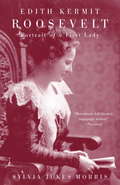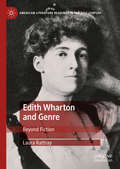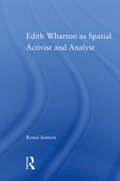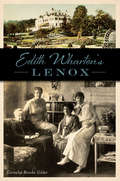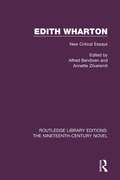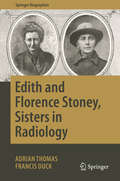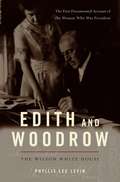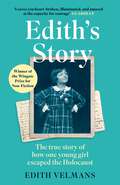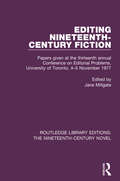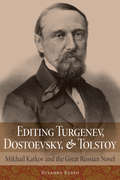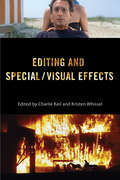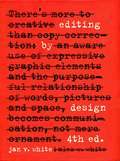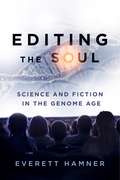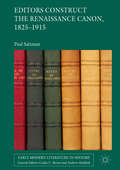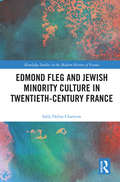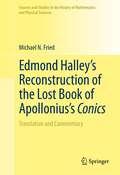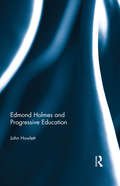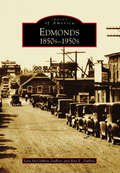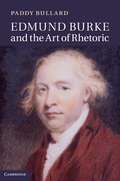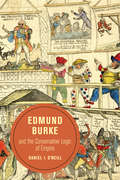- Table View
- List View
Edith Kermit Roosevelt
by Sylvia MorrisEdith Kermit Carow grew up in New York City in the same circles as did Theodore Roosevelt. But only after TR's first wife died at age twenty-two did the childhood friends forge one of the most successful romantic and political partnerships in American history. Sylvia Jukes Morris's access to previously unpublished letters and diaries brings to full life her portrait of the Roosevelts and their times. During her years as First Lady (1901-09), Edith Kermit Roosevelt dazzled social and political Washington as hostess, confidante, and mother of six, leading her husband to remark, "Mrs. Roosevelt comes a good deal nearer my ideal than I do myself."From the Trade Paperback edition.
Edith Wharton and Genre: Beyond Fiction (American Literature Readings in the 21st Century #3)
by Laura RattrayBased on extensive new archival research, Edith Wharton and Genre: BeyondFiction offers the first study of Wharton’s full engagement with original writing ingenres outside those with which she has been most closely identified. So muchmore than an acclaimed novelist and short story writer, Wharton is reconsideredin this book as a controversial playwright, a gifted poet, a trailblazing travelwriter, an innovative and subversive critic, a hugely influential design writer, andan author who overturned the conventions of autobiographical form. Herversatility across genres did not represent brief sidesteps, temporary diversionsfrom what has long been read as her primary role as novelist. Each was pursuedfully and whole-heartedly, speaking to Wharton’s very sense of herself as anartist and her connected vision of artistry and art. The stories of these other EdithWhartons, born through her extraordinary dexterity across a wide range ofgenres, and their impact on our understanding of her career, are the focus of thisnew study, revealing a bolder, more diverse, subversive and radical writer thanhas long been supposed.
Edith Wharton as Spatial Activist and Analyst (Studies in Major Literary Authors)
by Reneé SomersBecause she devoted much of her life to exploring the relationships that exist between people and their built environment, Edith Wharton developed a set of philosophies that she expressed in many arenas, including interior design, architecture, and landscaping. Her theories of space were practiced and materially executed, in addition to being expressed in her writing. This book explores Wharton's theories of space in Newport, Rhode Island during the Gilded Age when the town was transformed from a rustic seaport to a playground for the fabulously wealthy. The built environment played a pivotal role as social, economic and personal conflicts were enacted among private and public spaces. As a cultural worker and as an author, Wharton stood squarely in the middle of these conflicts and directly participated in them. Accordingly, the book shows Wharton in a new light by exploring texts such as The Decoration of Houses and The House of Mirth as well as by examining the architecture and aesthetics of three of Wharton's primary homes.
Edith Wharton's Lenox
by Cornelia Brooke GilderAn insider’s history of how famed novelist Wharton stirred up scandal in the western Massachusetts town.In 1900, Edith Wharton burst into the settled summer colony of Lenox. An aspiring novelist in her thirties, she was already a ferocious aesthete and intellect. She and her husband, Teddy, planned a defiantly classical villa, and she became a bestselling author with The House of Mirth in 1905. As a hostess, designer, gardener and writer, Wharton set high standards that delighted many, including Ambassador Joseph Choate and sculptor Daniel Chester French. But her perceptive and sometimes indiscreet pen also alienated potent figures like Emily Vanderbilt Sloane and Georgiana Welles Sargent. Author Cornelia Brooke Gilder gives an insider’s glimpse of the community’s reaction to this disruptive star during her tumultuous Lenox decade.
Edith Wharton: New Critical Essays (Routledge Library Editions: The Nineteenth-Century Novel #2)
by Alfred Bendixen Annette ZilversmitFirst published in 1992, this volume of essays celebrates the revival of Edith Wharton’s critical reputation. It offers a variety of approaches to the work of Wharton and examines largely neglected texts. It differs from many other collections of Wharton criticism in its insistence that the entire body of Wharton’s work deserves attention. This book will be of interest in those studying nineteenth century and American literature.
Edith and Florence Stoney, Sisters in Radiology (Springer Biographies)
by Adrian Thomas Francis DuckThis book explores the lives and achievements of two Irish sisters, Edith and Florence Stoney, who pioneered the use of new electromedical technologies, especially X-rays but also ultraviolet radiation and diathermy. In addition, the narrative follows several intertwined themes as experienced by the sisters during their lifetimes. Their upbringing, influenced by their liberal-minded scientist father, set the tone for both their lives. Irish independence fractured their family heritage. Their professional experiences, fulfilling for Florence as a qualified doctor but often frustrating for Edith as a Cambridge-educated scientist, mirrored those of other aspiring women during this period, when the suffragist movement expanded and women’s lobby groups were formed. World War I created an environment in which their unusual specialist knowledge was widely needed, and the sisters’ war experiences are carefully examined in the book. But ultimately this is the extraordinary story of two independent but closely bonded sisters and their abiding love and support for one another.
Edith and Woodrow: The Wilson White House
by Phyllis Lee LevinElegantly written, tirelessly researched, full of shocking revelations, Edith and Woodrow offers the definitive examination of the controversial role Woodrow Wilson's second wife played in running the country. "The story of Wilson's second marriage, and of the large events on which its shadow was cast, is darker and more devious, and more astonishing, than previously recorded. "-- from the PrefaceConstructing a thrilling, tightly contained narrative around a trove of previously undisclosed documents, medical diagnoses, White House memoranda, and internal documents, acclaimed journalist and historian Phyllis Lee Levin sheds new light on the central role of Edith Bolling Galt in Woodrow Wilson's administration. Shortly after Ellen Wilson's death on the eve of World War I in 1914, President Wilson was swept off his feet by Edith Bolling Galt. They were married in December 1915, and, Levin shows, Edith Wilson set out immediately to consolidate her influence on him and tried to destroy his relationships with Colonel House, his closest friend and adviser, and with Joe Tumulty, his longtime secretary. Wilson resisted these efforts, but Edith was persistent and eventually succeeded. With the quick ending of World War I following America's entry in 1918, Wilson left for the Paris Peace Conference, where he pushed for the establishment of the League of Nations. Congress, led by Senator Henry Cabot Lodge, resisted the idea of an international body that would require one country to go to the defense of another and blocked ratification. Defiant, Wilson set out on a cross-country tour to convince the American people to support him. It was during the middle of this tour, in the fall of 1919, that he suffered a devastating stroke and was rushed back to Washington. Although there has always been controversy regarding Edith Wilson's role in the eighteen months remaining of Wilson's second term, it is clear now from newly released medical records that the stroke had totally incapacitated him. Citing this information and numerous specific memoranda, journals, and diaries, Levin makes a powerfully persuasive case that Mrs. Wilson all but singlehandedly ran the country during this time. Ten years in the making, Edith and Woodrow is a magnificent, dramatic, and deeply rewarding work of history.
Edith's Story: The true story of how one young girl escaped the Holocaust (Virago Modern Classics #822)
by Edith VelmansTHE EXTRAORDINARY TRUE STORY OF HOW ONE YOUNG GIRL ESCAPED THE HOLOCAUST'It holds you with the same intensity as The Diary of Anne Frank and leaves you heart-broken, illuminated, and amazed at the capacity for courage' GUARDIAN***'I never realised that there could be such suffering in the world, and that anyone could live through it' - from Edith's diary, 1st July 1945After Germany occupied the Netherlands in 1940, fourteen-year-old Edith was still filling her diary with carefree stories of school, parties and boys. But her entries soon record a darkening world. By 1942, as the Nazis escalated their persecution of the Jewish population, Edith began a bitter struggle to survive.Hidden in plain sight but a courageous Christian family, with a German officer billeted in the next room, Edith faced the horrors of war under constant threat of discovery and betrayal. Weaving together Edith's diaries with letters smuggled between family members and her own memories, this extraordinary memoir of 'the Anne Frank who lived' is a profoundly moving account of grief, loss, courage - and one girl's remarkable belief in humanity in the face of despair.WITH A NEW INTRODUCTION BY ESTHER FREUD 'One of the best and most moving memoirs I have ever read' RUTH RENDELL'It's impossible to get through this inspiring and great-hearted volume dry-eyed' WASHINGTON POST'Both memoir and meditation, it is moving and wise . . . neither sanguine nor sentimental about the Holocaust and man's capacity for evil' LINDA HOLT, INDEPENDENT'Truly moving . . . leaving one with great hope in humanity' THE TIMESA VIRAGO MODERN CLASSIC
Editing Economics: Essays in Honour of Mark Perlman (Routledge Frontiers Of Political Economy #37)
by G. C. Harcourt Hank Lim Ungsuh K. ParkMark Perlman was the founding editor of the Journal of Economic Literature and responsible for issues from 1969 until 1980 when he retired. He has also written and edited a number of books and articles, concentrating on aspects of the labour market, population growth, health economics, the environment and the history of economics.
Editing Nineteenth-Century Fiction: Papers given at the thirteenth annual Conference on Editorial Problems, University of Toronto, 4-5 November 1977 (Routledge Library Editions: The Nineteenth-Century Novel #29)
by Jane MillgateFirst published in 1978, this collection of papers, first presented at the thirteenth annual Conference on Editorial Problems in 1977, focuses on the editing of nineteenth-century fiction. Four of the papers are devoted to single authors – Dickens, Thackeray, Hardy and Zola – while the fifth takes its principle examples from Hawthorne, Twain and Crane. Looking at a range of works from English, American and French literature, this volume demonstrates the number of different attitudes that exist towards the editorial process as well as the different ambitions for the texts that scholars seek to produce. This book will be of interest to those studying and editing nineteenth-century literature.
Editing Turgenev, Dostoevsky, and Tolstoy: Mikhail Katkov and the Great Russian Novel (NIU Series in Slavic, East European, and Eurasian Studies)
by Susanne FussoFathers and Sons by Turgenev. Anna Karenina by Tolstoy. Crime and Punishment by Dostoevsky. These are a few of the great works of Russian prose that first appeared in the Russian Herald, a journal founded and edited by Mikhail Katkov. Yet because of his conservative politics and intrusive editing practices, Katkov has been either ignored or demonized by scholars in both Russia and the West. In Putin's Russia, he is now being hailed as the "savior of the fatherland" due to his aggressive Russian nationalism. In Editing Turgenev, Dostoevsky, and Tolstoy, Susanne Fusso examines Katkov's literary career without vilification or canonization, focusing on the ways in which his nationalism fueled his drive to create a canon of Russian literature and support its recognition around the world. In each chapter, Fusso considers Katkov's relationship with a major Russian literary figure. In addition to Turgenev, Dostoevsky, and Tolstoy, she explores Katkov's interactions with Vissarion Belinsky, Evgeniia Tur, and the legacy of Aleksandr Pushkin. As a writer of articles and editorials, Katkov presented a clear program for Russian literature: to affirm the political and historical importance of the Russian nationality as expressed through its language. As a powerful and entrepreneurial publisher, he also sought, encouraged, and paid for the writing of the works that were to embody that program, the works we now recognize as among the greatest achievements of Russian literature. This groundbreaking study will fascinate scholars, students, and general readers interested in Russian literature and literary history.
Editing and Special/Visual Effects
by Kristen Whissel Dana Polan Ariel Rogers Scott Higgins Julie Turnock Tanine Allison Paul Monticone Dan North Professor Deron Overpeck Benjamin Wright Meraj Dhir Lisa Purse Professor Charlie KeilMost moviegoers think of editing and special effects as distinct components of the filmmaking process. We might even conceive of them as polar opposites, since effective film editing is often subtle and almost invisible, whereas special effects frequently call attention to themselves. Yet, film editors and visual effects artists have worked hand-in-hand from the dawn of cinema to the present day. Editing and Special/Visual Effects brings together a diverse range of film scholars who trace how the arts of editing and effects have evolved in tandem. Collectively, the contributors demonstrate how these two crafts have been integral to cinematic history, starting with the "trick films" of the early silent era, which astounded audiences by splicing in or editing out key frames, all the way up to cutting-edge effects technologies and concealed edits used to create the illusions. Throughout, readers learn about a variety of filmmaking techniques, from classic Hollywood's rear projection and matte shots to the fast cuts and wall-to-wall CGI of the contemporary blockbuster. In addition to providing a rich historical overview, Editing and Special/Visual Effects supplies multiple perspectives on these twinned crafts, introducing readers to the analog and digital tools used in each craft, showing the impact of changes in the film industry, and giving the reader a new appreciation for the processes of artistic collaboration they involve.
Editing by Design: The Classic Guide to Word-and-Picture Communication for Art Directors, Editors, Designers, and Students
by Alex W. White Jan V. WhiteAn Industry Classic, Revised for the Modern Age This classic guide to winning readers for designers, art directors, and editors, has been completely updated to be applicable to both online and print publication design. Because it has truths about effective visual communication that transcend ever-changing technology, this book has been in continuous publication since 1974. Revised with the careful attention of widely respected author and professor of graphic design Alex W. White, Editing by Design, Fourth Edition, describes how both word people and design people have the same task: to reveal the true core of each message as plainly and compellingly as possible. It is a book vital to creators of today&’s online and print media. Readers will find ways to marry content and form, helping story and design to reinforce each other, and create pages that are irresistible. Brimming with three hundred illustrations, chapters cover a wealth of design and editing matters, including: How to think about &“editing&” and &“design&” as a word person and a design personTeamwork and collaboration for story clarityOriginality and inducement for the readerColumns and grids for organization and consistencyCovers and content listings as tools for deeper reader involvementHow to use type hierarchy to catch and lure readersRepresentational and non-representational imageryUsing color as a branding device Readers will learn how editor-designer collaboration can achieve maximum creative impact through the effective use of words, images, and space. Full of practical examples, this book is equally for designers looking for a deeper understanding of how to design better and for writers and editors wanting to communicate more vividly with the utmost impact, as well as for editorial directors and publishers seeking a competitive advantage.
Editing the Soul: Science and Fiction in the Genome Age (AnthropoScene)
by Everett HamnerPersonal genome testing, gene editing for life-threatening diseases, synthetic life: once the stuff of science fiction, twentieth- and twenty-first-century advancements blur the lines between scientific narrative and scientific fact. This examination of bioengineering in popular and literary culture shows that the influence of science on science fiction is more reciprocal than we might expect.Looking closely at the work of Margaret Atwood, Richard Powers, and other authors, as well as at film, comics, and serial television such as Orphan Black, Everett Hamner shows how the genome age is transforming both the most commercial and the most sophisticated stories we tell about the core of human personhood. As sublime technologies garner public awareness beyond the genre fiction shelves, they inspire new literary categories like “slipstream” and shape new definitions of the human, the animal, the natural, and the artificial. In turn, what we learn of bioengineering via popular and literary culture prepares the way for its official adoption or restriction—and for additional representations. By imagining the connections between emergent gene testing and editing capacities and long-standing conversations about freedom and determinism, these stories help build a cultural zeitgeist with a sharper, more balanced vision of predisposed agency.A compelling exploration of the interrelationships among science, popular culture, and self, Editing the Soul sheds vital light on what the genome age means to us, and what’s to come.
Editing the Soul: Science and Fiction in the Genome Age (AnthropoScene: The SLSA Book Series #2)
by Everett HamnerPersonal genome testing, gene editing for life-threatening diseases, synthetic life: once the stuff of science fiction, twentieth- and twenty-first-century advancements blur the lines between scientific narrative and scientific fact. This examination of bioengineering in popular and literary culture shows that the influence of science on science fiction is more reciprocal than we might expect.Looking closely at the work of Margaret Atwood, Richard Powers, and other authors, as well as at film, comics, and serial television such as Orphan Black, Everett Hamner shows how the genome age is transforming both the most commercial and the most sophisticated stories we tell about the core of human personhood. As sublime technologies garner public awareness beyond the genre fiction shelves, they inspire new literary categories like “slipstream” and shape new definitions of the human, the animal, the natural, and the artificial. In turn, what we learn of bioengineering via popular and literary culture prepares the way for its official adoption or restriction—and for additional representations. By imagining the connections between emergent gene testing and editing capacities and long-standing conversations about freedom and determinism, these stories help build a cultural zeitgeist with a sharper, more balanced vision of predisposed agency.A compelling exploration of the interrelationships among science, popular culture, and self, Editing the Soul sheds vital light on what the genome age means to us, and what’s to come.
Editors Construct the Renaissance Canon, 1825-1915 (Early Modern Literature in History)
by Paul SalzmanThis book argues that nineteenth-century editors created the modern idea of English Renaissance literature. The book analyses the theories and practices of editors who worked on Shakespeare, but also on complete editions of a remarkable range of early modern writers, from the early nineteenth century through to the early twentieth century. It reassesses the point at which purportedly more scientific theories of editing began the process of obscuring the work of these earlier editors. In recreating this largely ignored history, this book also addresses the current interest in the theory and practice of editing as it relates to new approaches to early modern writing, and to literary and book history, and the material conditions of the transmission of texts. Through a series of case studies, the book explores the way individual editors dealt with Renaissance literature and with changing ideas of how texts and their contexts might be represented.
Edmond Fleg and Jewish Minority Culture in Twentieth-Century France (Routledge Studies in the Modern History of France)
by Sally CharnowEdmond Fleg and Jewish Minority Culture in Twentieth-Century France, the first critical biography of the leading French writer Edmond Fleg (1874–1963), explores his role in forging a modern French Jewish identity before and after the Second World War. Through his writings – plays, novels, poems, and essays based on Jewish and Christian texts – Fleg fashioned a minority identity within the context of French Third Republic universalism. At the heart of his work we find a radical ecumenism, a rejection of exclusive and homogenous nationalism, and a deep understanding of the necessity of supporting vibrant minority subcultures within the context of a liberal democratic republic. This account is both individual and social, pointing to the ways in which Fleg acted within the possibilities and constraints of his milieu and used his writing to engage with and shape the discursive fabric of twentieth-century French culture. This book appeals to a number of scholarly audiences, including historians and literary critics who work on modern France and Jewish and religious studies and those who focus on issues of identity and difference, as well as a more general audience interested in Modern France and/or modern Jewish history.
Edmond Halley’s Reconstruction of the Lost Book of Apollonius’s Conics
by Michael N. FriedApollonius's Conics was one of the greatest works of advanced mathematics in antiquity. The work comprised eight books, of which four have come down to us in their original Greek and three in Arabic. By the time the Arabic translations were produced, the eighth book had already been lost. In 1710, Edmond Halley, then Savilian Professor of Geometry at Oxford, produced an edition of the Greek text of the Conics of Books I-IV, a translation into Latin from the Arabic versions of Books V-VII, and a reconstruction of Book VIII. The present work provides the first complete English translation of Halley's reconstruction of Book VIII with supplementary notes on the text. It also contains 1) an introduction discussing aspects of Apollonius's Conics 2) an investigation of Edmond Halley's understanding of the nature of his venture into ancient mathematics, and 3) an appendices giving a brief account of Apollonius's approach to conic sections and his mathematical techniques. This book will be of interest to students and researchers interested in the history of ancient Greek mathematics and mathematics in the early modern period.
Edmond Holmes and Progressive Education
by John HowlettAlthough considered a figure of great importance and influence by his contemporaries, Edmond Holmes has been consigned to relative obscurity in the progressive educational tradition. This book reinstates Holmes as a key figure in the history of progressive education, both as a school inspector and educational thinker, who was instrumental in forming a set of ideas and principles which continue to resonate in education today. Combining biographical detail and key critical analysis, Edmond Holmes and Progressive Education brings together the key ideas and aspects of Holmes’ life and establishes his writings as amongst the most insightful ever produced by an educationalist. Throughout his inspectorial career, Holmes scorned mechanical obedience in the classroom and was appalled by the inability of teachers to allow pupils to express themselves freely and imaginatively. His seminal publications positioned him at the vanguard of educational reforms. His work, however, was not exclusively educational, and throughout his life Holmes published on religion, philosophy, poetry and literature, subsuming his educational viewpoint into a much wider ‘philosophy of life’. His spiritual leanings and call for an improved education system, which would draw out the potential for development from within the child, inspired successive generations of progressive educators. In studying Edmond Holmes in detail, this book makes an important contribution to current debates surrounding creativity and the curriculum, in particular, the need for alternative educational voices within the state system of regulation. This book will be key reading for postgraduate students and researchers who are interested in progressive education, the history of education and educational policy and politics.
Edmond Holmes and Progressive Education
by John HowlettAlthough considered a figure of great importance and influence by his contemporaries, Edmond Holmes has been consigned to relative obscurity in the progressive educational tradition. This book reinstates Holmes as a key figure in the history of progressive education, both as a school inspector and educational thinker, who was instrumental in forming a set of ideas and principles which continue to resonate in education today. Combining biographical detail and key critical analysis, Edmond Holmes and Progressive Education brings together the key ideas and aspects of Holmes’ life and establishes his writings as amongst the most insightful ever produced by an educationalist.Throughout his inspectorial career, Holmes scorned mechanical obedience in the classroom and was appalled by the inability of teachers to allow pupils to express themselves freely and imaginatively. His seminal publications positioned him at the vanguard of educational reforms. His work, however, was not exclusively educational, and throughout his life Holmes published on religion, philosophy, poetry and literature, subsuming his educational viewpoint into a much wider ‘philosophy of life’. His spiritual leanings and call for an improved education system, which would draw out the potential for development from within the child, inspired successive generations of progressive educators.In studying Edmond Holmes in detail, this book makes an important contribution to current debates surrounding creativity and the curriculum, in particular, the need for alternative educational voices within the state system of regulation. This book will be key reading for postgraduate students and researchers who are interested in progressive education, the history of education and educational policy and politics.
Edmond Oklahoma: Always Growing
by Jan MattinglyFrom its humble beginnings in 1886 as a fuel and water pump house at Mile Marker 103 of the Santa Fe Railroad, through the eras of land run, statehood, oil boom, two world wars and beyond, the city of Edmond has always been growing. Today, a "beacon for the rest of Oklahoma," it boasts a vibrant community of over 70,000 residents. Edmond is home to the state's oldest continuously running newspaper, the Edmond Sun. The first church and schoolyard in Oklahoma Territory were located here, as well as the state's first institute for higher learning. Indeed, Central Normal School, now called the University of Central Oklahoma, has been at the heart of Edmond since the 1890s and is featured prominently throughout this book. Edmond is a railroad town, an oil town and a college town, depending on who you ask; but Edmondites both past and present simply know it as the "perfect town." Edmond, Oklahoma: Always Growing tells the story of this proud city through more than two hundred vintage photographs, many dating back to before the turn of the twentieth century.
Edmonds: 1850s–1950s
by Sara Mcgibbon Dubois Ray E. DuboisBefore Edmonds became a town, it was a forest of cedar trees and evergreens. The Puget Sound's various Indian tribes used the land for camping, the sea for fishing and clamming for meals, and the marshes for harvesting tules that they used to weave into items such as mats and baskets. Later, the area became known as Brackett's Landing, named after the man who began logging the forest and founded the town of Edmonds in 1890 and opened its first mills and schools. The Great Northern Railway arrived in 1891, bringing with it great prospects for commercial and residential prosperity. As the young town grew into a city, it thrived because of its location on the water. Private ferry boats called the "Mosquito Fleet" came from Seattle, and to this day, commercial and passenger ferries cross the Puget Sound to the Port of Edmonds, Kingston, and the rest of the Olympic peninsula.
Edmund Booth: Deaf Pioneer
by Harry G. LangEdmund Booth was born in 1810 and died in 1905, and during the 94 years of his life, he epitomized virtually everything that characterized an American legend of that century. In his prime, Booth stood 6 feet, 3 inches tall, weighed in at 210 pounds, and wore a long, full beard. He taught school in Hartford, CT, then followed his wife-to-be Mary Ann Walworth west to Anamosa, Iowa, where in 1840, he built the area's first frame house. He pulled up stakes nine years later to travel the Overland Trail on his way to join the California Gold Rush. After he returned to Iowa in 1854, he became the editor of the Anamosa Eureka, the local newspaper. Edmund Booth fit perfectly the mold of the ingenious pioneer of 19th-century America, except for one unusual difference -- he was deaf. Edmund Booth: Deaf Pioneer follows the amazing career of this American original and his equally amazing wife in fascinating detail. Author Harry G. Lang vividly portrays Booth and his wife by drawing from a remarkable array of original material. A prolific writer, Booth corresponded with his fiancé from the American School for the Deaf in Hartford, and he kept a journal during his days on the California trail, parts of which have been reproduced here. He also wrote an autobiographical essay when he was 75, and his many newspaper articles through the years bore first-hand witness to the history of his times, from the Civil War to the advent of the 20th century. Edmund Booth depicts a larger-than-life man in larger-than-life times, but perhaps its greatest contribution derives from its narrative about pioneer days as seen through Deaf eyes. Booth became a respected senior statesman of the American Deaf community, and blended with his stories of the era's events are anecdotes and issues vital to Deaf people and their families. His story proves again that extraordinary people vary in many ways, but they often possess a common motive in acting to enhance their own communities.
Edmund Burke and the Art of Rhetoric
by Paddy BullardEdmund Burke ranks among the most accomplished orators ever to debate in the British Parliament. But often his eloquence has been seen to compromise his achievements as a political thinker. In the first full-length account of Burke's rhetoric, Bullard argues that Burke's ideas about civil society, and particularly about the process of political deliberation, are, for better or worse, shaped by the expressiveness of his language. Above all, Burke's eloquence is designed to express ethos or character. This rhetorical imperative is itself informed by Burke's argument that the competency of every political system can be judged by the ethical knowledge that the governors have of both the people that they govern and of themselves. Bullard finds the intellectual roots of Burke's 'rhetoric of character' in early modern moral and aesthetic philosophy, and traces its development through Burke's parliamentary career to its culmination in his masterpiece, Reflections on the Revolution in France.
Edmund Burke and the Conservative Logic of Empire
by Daniel O'NeillEdmund Burke, long considered modern conservatism's founding father, is also widely believed to be an opponent of empire. However, Daniel O'Neill turns that latter belief on its head. This fresh and innovative book shows that Burke was a passionate supporter and staunch defender of the British Empire in the eighteenth century, whether in the New World, India, or Ireland. Moreover--and against a growing body of contemporary scholarship that rejects the very notion that Burke was an exemplar of conservatism--O'Neill demonstrates that Burke's defense of empire was in fact ideologically consistent with his conservative opposition to the French Revolution. Burke's logic of empire relied on two opposing but complementary theoretical strategies: Ornamentalism, which stressed cultural similarities between "civilized" societies, as he understood them, and Orientalism, which stressed the putative cultural differences distinguishing "savage" societies from their "civilized" counterparts. This incisive book also shows that Burke's argument had lasting implications, as his development of these two justifications for empire prefigured later intellectual defenses of British imperialism.
